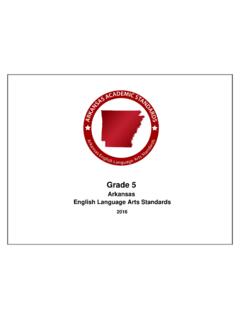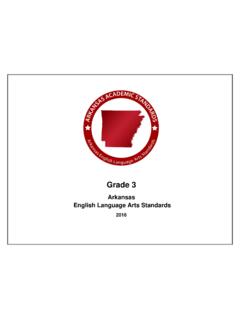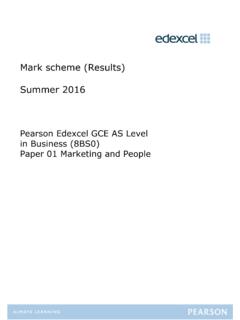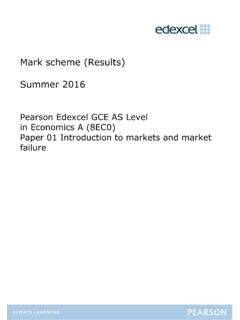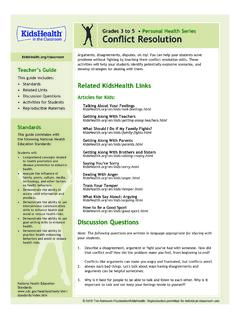Transcription of Grades 5-8 - Arkansas Department of Education
1 Re-aligned Fall 2016 to the Arkansas Mathematics Standards, Arkansas English Language Arts Standards, and Arkansas Disciplinary Literacy Standards Grades 5-8 20152 Grades 5-8 Arkansas K-12 Science Standards Arkansas Department of Education 2015 Table of Contents Grades 5-8 Science Core Ideas and Science 5-8 How to Read the Grade Five Earth s Systems .. 6 Space Systems: Stars and the Solar System .. 8 Structure and Properties of Matter .. 10 Matter and Energy in Organisms and Ecosystems .. 12 Engineering, Technology, and Applications of Science .. 14 Grade Six Energy .. 16 Structure, Function, and Information Processing .. 18 Growth, Development, and Reproduction of Organisms.
2 20 Earth s Systems .. 22 Human Impacts .. 23 Weather and Climate .. 25 Engineering, Technology, and Applications of Science .. 27 Grade Seven Structure and Properties of Matter .. 29 Chemical Reactions .. 31 Interdependent Relationships in Ecosystems .. 33 Matter and Energy in Organisms and Ecosystems .. 35 Earth s Systems .. 38 History of Earth .. 40 Human Impacts .. 42 Engineering, Technology, and Applications of Science .. 43 Grade Eight Waves and Electromagnetic Radiation .. 45 Forces and Interactions .. 47 Energy .. 50 Space Systems .. 52 History of Earth .. 54 Growth, Development, and Reproduction of Organisms .. 55 Natural Selection and Adaptations .. 57 Engineering, Technology, and Applications of Science .. 59 5-8 Learning Progressions and Standards Overview Grade Grade Grade Grade Accelerated course Contributors.
3 61 3 Grades 5-8 Arkansas K-12 Science Standards Arkansas Department of Education 2015 How to Read Arkansas K-12 Science Standards Grades 5-8 Science Core Ideas and Topics Overview 4 Grades 5-8 Arkansas K-12 Science Standards Arkansas Department of Education 2015 Arkansas K-12 Science Standards Overview The Arkansas K-12 Science Standards are based on A Framework for K-12 Science Education (NRC 2012) and are meant to reflect a new vision for science Education . The following conceptual shifts reflect what is new about these science standards. The Arkansas K-12 Science Standards reflect science as it is practiced and experienced in the real world, build logically from Kindergarten through Grade 12, focus on deeper understanding as well as application of content, integrate practices, crosscutting concepts, and core ideas, and make explicit connections to literacy and math.
4 As part of teaching the Arkansas K-12 Science Standards, it will be important to instruct and guide students in adopting appropriate safety precautions for their student-directed science investigations. Reducing risk and preventing accidents in science classrooms begin with planning. The following four steps are recommended in carrying out a hazard and risk assessment for any planned lab investigation: 1) Identify all hazards. Hazards may be physical, chemical, health, or environmental. 2) Evaluate the type of risk associated with each hazard. 3) Write the procedure and all necessary safety precautions in such a way as to eliminate or reduce the risk associated with each hazard. 4) Prepare for any emergency that might arise in spite of all of the required safety precautions. According to Arkansas Code Annotated 6-10-113 (2012) for eye protection, every student and teacher in public schools participating in any chemical or combined chemical-physical laboratories involving caustic or explosive chemicals or hot liquids or solids is required to wear industrial-quality eye protective devices (eye goggles) at all times while participating in science investigations.
5 The Arkansas K-12 Science Standards outline the knowledge and science and engineering practices that all students should learn by the end of high school. The standards are three-dimensional because each student performance expectation engages students at the nexus of the following three dimensions: Dimension 1 describes scientific and engineering practices. Dimension 2 describes crosscutting concepts, overarching science concepts that apply across science disciplines. Dimension 3 describes core ideas in the science disciplines. Science and Engineering Practices The eight practices describe what scientists use to investigate and build models and theories of the world around them or that engineers use as they build and design systems. The practices are essential for all students to learn and are as follows: 1. Asking questions (for science) and defining problems (for engineering) 2.
6 Developing and using models 3. Planning and carrying out investigations 4. Analyzing and interpreting data 5. Using mathematics and computational thinking 6. Constructing explanations (for science) and designing solutions (for engineering) 7. Engaging in argument from evidence 8. Obtaining, evaluating, and communicating information Crosscutting Concepts The seven crosscutting concepts bridge disciplinary boundaries and unit core ideas throughout the fields of science and engineering. Their purpose is to help students deepen their understanding of the disciplinary core ideas, and develop a coherent, and scientifically based view of the world. The seven crosscutting concepts are as follows: 1. Patterns- Observed patterns of forms and events guide organization and classification, and prompt questions about relationships and the factors that influence them.
7 5 Grades 5-8 Arkansas K-12 Science Standards Arkansas Department of Education 2015 2. Cause and effect- Mechanism and explanation. Events have causes, sometimes simple, sometimes multifaceted. A major activity of science is investigating and explaining causal relationships and the mechanisms by which they are mediated. Such mechanisms can then be tested across given contexts and used to predict and explain events in new contexts. 3. Scale, proportion, and quantity- In considering phenomena, it is critical to recognize what is relevant at different measures of size, time, and energy and to recognize how changes in scale, proportion, or quantity affect a system s structure or performance. 4. Systems and system models- Defining the system under study specifying its boundaries and making explicit a model of that system provides tools for understanding and testing ideas that are applicable throughout science and engineering.
8 5. Energy and matter: Flows, cycles, and conservation- Tracking fluxes of energy and matter into, out of, and within systems helps one understand the systems possibilities and limitations. 6. Structure and function- The way in which an object or living thing is shaped and its substructure determines many of its properties and functions. 7. Stability and change- For natural and built systems alike, conditions of stability and determinants of rates of change or evolution of a system are critical elements of study. Disciplinary Core Ideas The disciplinary core ideas describe the content that occurs at each grade or course. The Arkansas K-12 Science Standards focus on a limited number of core ideas in science and engineering both within and across the disciplines and are built on the notion of learning as a developmental progression.
9 The Disciplinary Core Ideas are grouped into the following domains: Physical Science (PS) Life Science (LS) Earth and Space Science (ESS) Engineering, Technology and Applications of Science (ETS) Connections to the Arkansas English Language Arts Standards Evidence-based reasoning is the foundation of good scientific practice. The Arkansas K-12 Science Standards incorporate reasoning skills used in language arts to help students improve mastery and understanding in all three disciplines. The Arkansas K-8 Science Committee made every effort to align grade-by-grade with the English language arts (ELA) standards so concepts support what students are learning in their entire curriculum. Connections to specific ELA standards are listed for each student performance expectation, giving teachers a blueprint for building comprehensive cross-disciplinary lessons.
10 The intersections between Arkansas K-12 Science Standards and Arkansas ELA Standards teach students to analyze data, model concepts, and strategically use tools through productive talk and shared activity. Reading in science requires an appreciation of the norms and conventions of the discipline of science, including understanding the nature of evidence used, an attention to precision and detail, and the capacity to make and assess intricate arguments, synthesize complex information, and follow detailed procedures and accounts of events and concepts. These practice-based standards help teachers foster a classroom culture where students think and reason together, connecting around the subject matter and core ideas. Connections to the Arkansas Disciplinary Literacy Standards Reading is critical to building knowledge in science.





